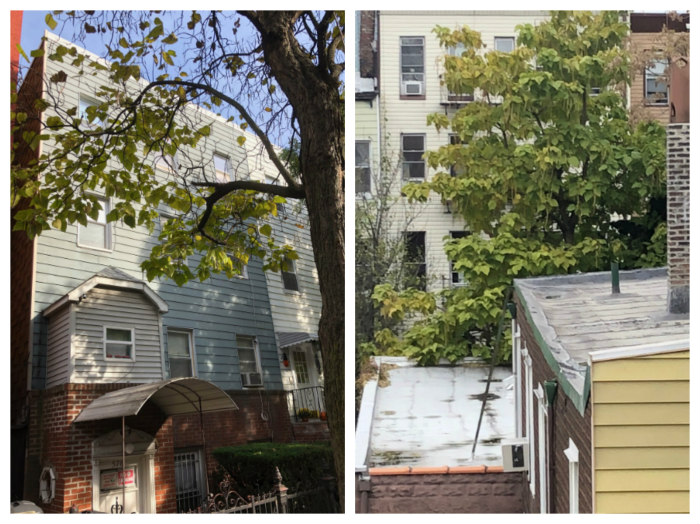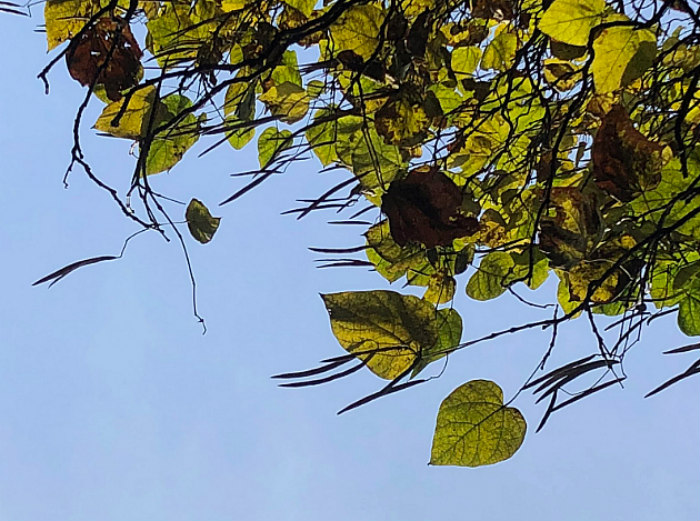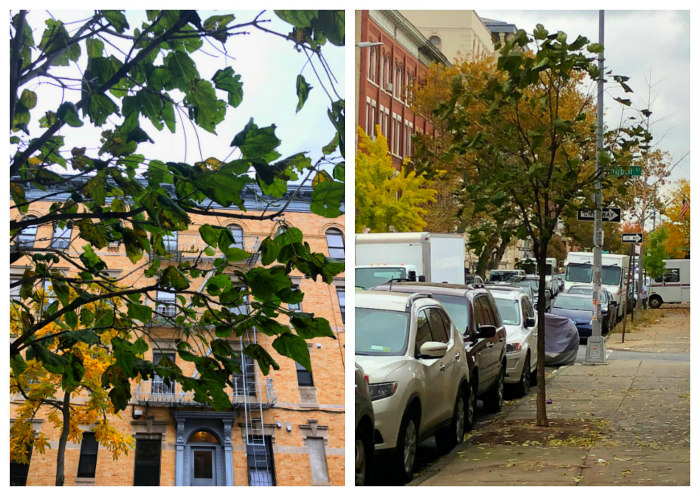
The Wings of the Garden
Seven days before Thanksgiving, the snow falls steadily outside my window, outlining the shape of the trees, many of them already leafless. The signs of the approaching solstice call for an article about evergreens. Shouldn’t I be writing about firs, hollies, spruces? Isn’t it time to celebrate the survival of nature in the resilient green of yews and pines now that the nights grow longer and colder? No doubt. Yet, I’ve felt compelled to answer an unseasonal call.
There aren’t too many catalpa trees in our neighborhood, but I am lucky to have one growing not 200 feet from my bedroom window, in the backyard of the building across the street. Every morning it greets me, flapping those same giant leaves that are now coated with heavy snow. The Merriam-Webster entry for ‘catalpa’ indicates that the noun derives from the Creek katáłpa, a compound word that translates literally as “winged head.” There are mornings when indeed those heart-shaped leaves suggest hundreds of wings ready to take flight.
My first encounter with the catalpa was a literary one. I clearly remember reading the name for the first time a couple of decades ago in one of the many epitaphs that make up Edgar Lee Master’s Spoon River Anthology. In the poem the catalpas grow among acacias, a very familiar tree that has been a biological constant in my life. I guess these acacias were the reason why I never bother to look the catalpa up—I decided it was just another beautiful, shady tree like the acacia, ideal to set the stage for what happens in the poem. Then recently—as recent as this year—I put a face to the name, or better yet: I put a leaf to the name. Naturally, we had met before. I just hadn’t realized that such unique, antediluvian-looking tree with its big leaves and orchid-like white flowers was what it was. I was thrilled when I finally made the connection: that last piece of the poem clicked as I visualized the meaning of catalpa. But let’s take a look at the text, the epitaph of Spoon River’s deceased character Francis Turner:
I could not run or play
In boyhood.
In manhood I could only sip the cup,
Not drink—
For scarlet-fever left my heart diseased.
Yet I lie here
Soothed by a secret none but Mary knows:
There is a garden of acacia,
Catalpa trees, and arbors sweet with vines—
There on that afternoon in June
By Mary’s side—
Kissing her with my soul upon my lips
It suddenly took flight.
Francis Turner’s epitaph speaks of grace, of a unique moment of bliss that gives meaning and fulfillment to the apparently dull life of a sickly man in a dreary small town. The catalpas play a fundamental role in delivering that moment of bliss— I can clearly see that it was the heart-shaped wings of the catalpa trees, animated by the miracle of a soulful kiss, which gave that graceful garden wings.

Raleigh’s Treasure
Two old catalpa trees grow at the end of the main avenue in the Gray’s Inn Walks, a garden in London planned by the philosopher Francis Bacon in the early 1600s. They are two southern catalpas, also known as Indian bean trees or cigar trees. They are said to descend from a Catalpa bignonoides brought by Sir Walter Raleigh in 1586 from Virginia, as a plant sample from a continent virtually unknown to Europeans a little less than a century before. The catalpa was one of three important botanical curiosities brought by Raleigh from his trip, the other two being tobacco and potato, two crops thathave had a huge impact in our history as species. Bacon himself is believed to have planted Raleigh’s least impactful American product, the catalpa, in that old garden, reputedly a prominent haunt of scholars and other illustrious people of that time. Catalpas have a primeval, almost obscene look with their flamboyant flowers, hanging seed pods and lush canopies packed with dinosaur food. I can see why Raleigh would have chosen it as a representative sample of the surprises that awaited Europeans on the other side of the Atlantic in that Age of Exploration. It’s not hard to imagine the father of the scientific method fascinated by this tree from the New World.
With that same exploratory spirit, but with the invaluable help of the New York City Street Tree Map, I set out a couple of weeks ago to survey the catalpa trees that grow in the sidewalks of our neighborhood. My first stop is on Leonard Street, not far from the elm sapling I wrote about less than a year ago. As I approach on my bike I recognize the long seed pods—the reason why some call it the “cigar tree”—and the heart shaped leaves from a block away. It’s a beautiful specimen, and I am not sure at all how old it might be. Catalpas are fast-growing plants, so it could be younger than it looks. The foliage in this one doesn’t seem as lavish as the one I can see from my bedroom window, and I can’t tell for sure that they are the exact same species. It is a healthy, tall and definitely mature tree, and at this hour it casts a beautiful shadow on the façade of 576 Leonard.

Right on the corner of Driggs and Lorimer, to the left of the main path entering McCarren Park, grows another beautiful catalpa tree. Although the New York City Street Tree Map does not list trees that grow in the city’s parks, it was easy for me to find this tree—this was the first specimen I recognized as a catalpa on my own. In summer it flames against the sky like a flock of silent parrots. Today, it seems ready to let go of those huge remaining leaves. I linger for a minute and then continue on my quest.

Cutting across the park, I ride down to the corner of Dobbin and Meserole, where the tree map indicates the growing site of another catalpa tree. This one is a little sapling, barely twice my height. I looked around self-consciously after realizing I was actually cooing at the baby tree. Since no one was seeing, I also wished him good luck before cycling away.
The tree map doesn’t list any other catalpa trees in our neighborhood. I can’t complete my exploration without mentioning those that grow in the private gardens and lots of Greenpoint. Look for them and you’ll find them. This takes us back to the catalpa that grows in the building across the street from my apartment: it closes my little catalpa circuit. Now that the snow is mostly gone, I am pleased to see that many of the leaves still hold tight to its branches.

The Catalpa Tree Appreciation Society
The catalpa is a fast-growing species ideal for the reforestation of lost woodland. Many arboriculture texts ponder the durability and beauty of the catalpa wood, citing its use by Native Americans in the construction of canoes for its water resistant properties. In an article published by the New York Times in 2014, author Michael Tortorello speaks of a “catalpa craze” that started in the nineteenth century and extended into the early decades of the past century. Later, however, the catalpa fell from from grace with horticulturists. Very few gardeners, Mr. Tortorello explains, have planted the tree since the 1930s. He basically points at two practical considerations for this: the catalpa is a messy tree; those big leaves and seed pods are hard to remove after falling and constitute an ideal breeding ground for mildew. The species, though native to the central and southern portions of the North American continent, is also considered an invasive plant in the Northeast.
None of these reasons should stop us from joining the Catalpa Tree Appreciation Society. As Mr. Tortorello stated in the onset of his article, all you have to do to be a member of this imaginary society is appreciate the catalpa tree. We know, after all, that the species is still very much present in the streets, parks, gardens and empty lots of New York City. We know that birds love the broad leaves of the catalpa and favor it as a shelter. We even know that in the right circumstances, it can make a garden fly. And now that you know where to find a few of those catalpas in our neighborhood, I suggest you go pay them a visit: they are a beautiful sight even in the winter. They will be simply glorious when they bloom again next spring.
***
More Tree Tales from GoGreen BK:
- An Oak Tree Grows in Greenpoint. José Miguel López. October 18, 2018
- Greenpoint Had a Fig Tree. José Miguel López. September 19, 2018
- Poet Tree. José Miguel López. April 5, 2018.
If you want to do your part in keeping Greenpoint Green, consider adopting and planting a tree! Greening Greenpoint has a free tree giveaway on November 28.


